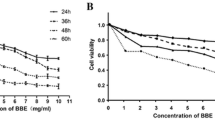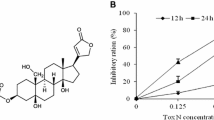Abstract
β-ionone has been shown to hold potent anti-proliferative and apoptosis induction properties in vitro and in vivo. To investigate the effects of β-ionone on apoptosis initiation and its possible mechanisms of action, we qualified cell apoptosis, proteins related to apoptosis and a phosphatidylinositol 3-kinase (PI3K)—AKT pathway in human gastric adenocarcinoma cancer SGC-7901 cells. The results demonstrated that β-ionone-induced apoptosis in a dose-dependent manner in SGC-7901 cells treated with β-ionone (25, 50, 100 and 200 μmol/L) for 24 h. β-ionone was also shown to induce the expression of cleaved-caspase-3 and inhibit bcl-2 expression in SGC-7901 cells in a dose-dependent manner. The significantly decreased levels of p-PI3K and p-AKT expression were observed in SGC-7901 cells after β-ionone treatments in a time- and dose-dependent manner (P < 0.01). Thus, the apoptosis induction in SGC-7901 cells by β-ionone may be regulated through a PI3K-AKT pathway. These results demonstrate a potential mechanism by which β-ionone to induce apoptosis initiation in SGC-7901 cells.






Similar content being viewed by others
References
Asokkumar S, Naveenkumar C, Raghunandhakumar S et al (2012) Antiproliferative and antioxidant potential of beta-ionone against benzo(a)pyrene-induced lung carcinogenesis in Swiss albino mice. Mol Cell Biochem 363(1–2):335–345
Aubry JP, Blaecke A, Lecoanet-Henchoz S et al (1999) Annexin V used for measuring apoptosis in the early events of cellular cytotoxicity. Cytometry 37(3):197–204
Bacso Z, Eliason JF (2001) Measurement of DNA damage associated with apoptosis by laser scanning cytometry. Cytometry 45(3):180–186
Bacso Z, Everson RB, Eliason JF (2000) The DNA of annexin V-binding apoptotic cells is highly fragmented. Cancer Res 60(16):4623–4628
Baskic D, Popovic S, Ristic P, Arsenijevic NN (2006) Analysis of cycloheximide-induced apoptosis in human leukocytes: fluorescence microscopy using annexin V/propidium iodide versus acridin orange/ethidium bromide. Cell Biol Int 30(11):924–932
Bazuro GE, Torino F, Gasparini G, Capurso L (2008) Chemoprevention in gastrointestinal adenocarcinoma: for few but not for all? Minerva Gastroenterol Dietol 54(4):429–444
Bi S, Liu JR, Li Y et al (2010) Gamma-tocotrienol modulates the paracrine secretion of VEGF induced by cobalt(II) chloride via ERK signaling pathway in gastric adenocarcinoma SGC-7901 cell line. Toxicology 274(1–3):27–33
Block G, Patterson B, Subar A (1992) Fruit, vegetables, and cancer prevention: a review of the epidemiological evidence. Nutr Cancer 18(1):1–29
Cantley LC (2002) The phosphoinositide 3-kinase pathway. Science 296(5573):1655–1657 (New York NY)
Chen BQ, Xue YB, Liu JR et al (2003) Inhibition of conjugated linoleic acid on mouse forestomach neoplasia induced by benzo (a) pyrene and chemopreventive mechanisms. World J Gastroenterol 9(1):44–49
Chen HS, Liu M, Shi LJ et al (2011) Effects of raspberry phytochemical extract on cell proliferation, apoptosis, and serum proteomics in a rat model. J Food Sci 76(8):T192–T198
de Moura Espindola R, Mazzantini RP, Ong TP, de Conti A, Heidor R, Moreno FS (2005) Geranylgeraniol and beta-ionone inhibit hepatic preneoplastic lesions, cell proliferation, total plasma cholesterol and DNA damage during the initial phases of hepatocarcinogenesis, but only the former inhibits NF-kappaB activation. Carcinogenesis 26(6):1091–1099
Doll R, Peto R (1981) The causes of cancer: quantitative estimates of avoidable risks of cancer in the United States today. J Natl Cancer Inst 66(6):1191–1308
Du J, Hu Z, Mitch WE (2005) Molecular mechanisms activating muscle protein degradation in chronic kidney disease and other catabolic conditions. Eur J Clin Invest 35(3):157–163
Duncan RE, Lau D, El-Sohemy A, Archer MC (2004) Geraniol and beta-ionone inhibit proliferation, cell cycle progression, and cyclin-dependent kinase 2 activity in MCF-7 breast cancer cells independent of effects on HMG-CoA reductase activity. Biochem Pharmacol 68(9):1739–1747
Eastman A, Rigas JR (1999) Modulation of apoptosis signaling pathways and cell cycle regulation. Seminars in oncology 26(5 Suppl 16):7–16 (discussion 41–42)
Elson CE, Yu SG (1994) The chemoprevention of cancer by mevalonate-derived constituents of fruits and vegetables. J Nutr 124(5):607–614
Fleischauer AT, Arab L (2001) Garlic and cancer: a critical review of the epidemiologic literature. J Nutr 131(3 s):1032S–1040S
Gross A (2005) Mitochondrial carrier homolog 2: a clue to cracking the BCL-2 family riddle? J Bioenerg Biomembr 37(3):113–119
He L, Mo H, Hadisusilo S, Qureshi AA, Elson CE (1997) Isoprenoids suppress the growth of murine B16 melanomas in vitro and in vivo. J Nutr 127(5):668–674
Jemal A, Bray F, Center MM, Ferlay J, Ward E, Forman D (2011) Global cancer statistics. CA Cancer J Clin 61(2):69–90. doi:10.3322/caac.20107
Liu JR, Chen BQ, Yang BF et al (2004a) Apoptosis of human gastric adenocarcinoma cells induced by beta-ionone. World J Gastroenterol 10(3):348–351
Liu JR, Yang BF, Chen BQ, Yang YM, Dong HW, Song YQ (2004b) Inhibition of beta-ionone on SGC-7901 cell proliferation and upregulation of metalloproteinases-1 and -2 expression. World J Gastroenterol 10(2):167–171
Liu JR, Sun XR, Dong HW et al (2008) beta-Ionone suppresses mammary carcinogenesis, proliferative activity and induces apoptosis in the mammary gland of the Sprague-Dawley rat. Int J Cancer 122(12):2689–2698
Liu JR, Dong HW, Chen BQ, Zhao P, Liu RH (2009) Fresh apples suppress mammary carcinogenesis and proliferative activity and induce apoptosis in mammary tumors of the Sprague-Dawley rat. J Agric Food Chem 57(1):297–304
Liu JR, Dong HW, Sun XR et al (2010) Effects of β-ionone on mammary carcinogenesis and antioxidant status in rats treated With DMBA. Nutr Cancer 62(1):58–65
Mironova EV, Evstratova AA, Antonov SM (2007) A fluorescence vital assay for the recognition and quantification of excitotoxic cell death by necrosis and apoptosis using confocal microscopy on neurons in culture. J Neurosci Methods 163(1):1–8. doi:10.1016/j.jneumeth.2007.02.010
Mo H, Elson CE (1999) Apoptosis and cell-cycle arrest in human and murine tumor cells are initiated by isoprenoids. J Nutr 129(4):804–813
Ribble D, Goldstein NB, Norris DA, Shellman YG (2005) A simple technique for quantifying apoptosis in 96-well plates. BMC Biotechnol 5:12. doi:10.1186/1472-6750-5-12
Shaw RJ, Cantley LC (2006) Ras, PI(3)K and mTOR signalling controls tumour cell growth. Nature 441(7092):424–430
Shounan Y, Feng X, O’Connell PJ (1998) Apoptosis detection by annexin V binding: a novel method for the quantitation of cell-mediated cytotoxicity. J Immunol Methods 217(1–2):61–70
Simkin AJ, Underwood BA, Auldridge M et al (2004) Circadian regulation of the PhCCD1 carotenoid cleavage dioxygenase controls emission of beta-ionone, a fragrance volatile of petunia flowers. Plant Physiol 136(3):3504–3514. doi:10.1104/pp.104.049718
Sporn MB, Suh N (2002) Chemoprevention: an essential approach to controlling cancer. Nat Rev Cancer 2(7):537–543
Sun W, Xu W, Liu H et al (2009) Gamma-tocotrienol induces mitochondria-mediated apoptosis in human gastric adenocarcinoma SGC-7901 cells. J Nutr Biochem 20(4):276–284
Takahashi-Yanaga F, Sasaguri T (2008) GSK-3beta regulates cyclin D1 expression: a new target for chemotherapy. Cell Signal 20(4):581–589
Vainio H, Bianchini F (2001) Evaluation of cancer-preventive agents and strategies a new program at the International Agency for Research on Cancer. Ann NY Acad Sci 952:177–180
Vieira A, Heidor R, Cardozo MT et al (2011) Efficacy of geraniol but not of beta-ionone or their combination for the chemoprevention of rat colon carcinogenesis. Braz J Med Biol Res = Revista brasileira de pesquisas medicas e biologicas/Sociedade Brasileira de Biofisica [et al. 44(6):538–545
Willett WC (2002) Balancing life-style and genomics research for disease prevention. Science 296:695–698 (New York, NY)
Yu SG, Anderson PJ, Elson CE (1995) Efficacy of β-ionone in the chemoprevention of rat mammary carcinogenesis. J Agric Food Chem 43:2144–2147
Zhang JS, Li DM, He N et al (2011) A paraptosis-like cell death induced by delta-tocotrienol in human colon carcinoma SW620 cells is associated with the suppression of the Wnt signaling pathway. Toxicology 285(1–2):8–17
Acknowledgments
This research was supported by the National Natural Science Fund (No. 30200229 and 30772511), China Postdoctoral Fund (No. 2003033383), HeiLongJiang Postdoctoral Fund (No. LRB03-000120), planning program of key problems from Sanitation Bureau of Heilongjiang province (No. 2007-470), and Department of Education, HeiLongJiang Province (No. 12521274), People’s Republic of China.
Conflict of interest
The authors declare that there is no conflict of interests in this study.
Author information
Authors and Affiliations
Corresponding authors
Additional information
Qian Liu, Hong-Wei Dong, Wen-Guang Sun and Ming Liu are co-first authors.
Rights and permissions
About this article
Cite this article
Liu, Q., Dong, HW., Sun, WG. et al. Apoptosis initiation of β-ionone in SGC-7901 gastric carcinoma cancer cells via a PI3K-AKT pathway. Arch Toxicol 87, 481–490 (2013). https://doi.org/10.1007/s00204-012-0962-8
Received:
Accepted:
Published:
Issue Date:
DOI: https://doi.org/10.1007/s00204-012-0962-8




